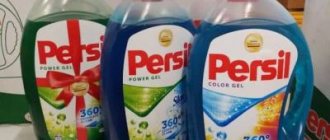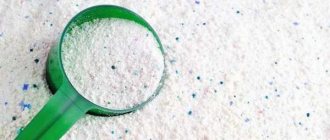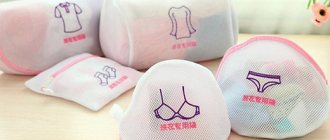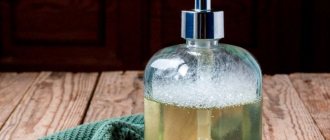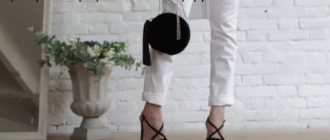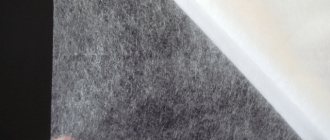- Use of oxygen bleaches
If earlier, when asked which laundry bleach is the best, any housewife would answer: “Whiteness” - but now everything is not so simple. The variety of household chemicals causes confusion for many. To find out how modern bleaches work, we decided to take a closer look at each of the existing types.
When choosing laundry detergents, check their composition and read the manufacturer’s recommendations for use.
Tip 1: Before bleaching, check the durability of the products
Before using chlorine bleach on clothing, you should test how the product behaves. Mix one teaspoon of bleach with two teaspoons of warm water. Select an inconspicuous area on the garment that is made of the same fabric as the garment itself, such as an inseam or the inside of a pocket. Using a cotton swab, apply the solution to the fabric. Leave until completely dry. If you notice a discoloration or staining of the stick to match the color of the fabric, this means that the fabric is not colorfast and should not be used with bleach.
This is especially true for clothes made of polyester, nylon and other non-natural fabrics. Chlorine bleach can turn your crisp white blouse yellow by eating away at the outer coating of the polyester fibers and exposing their inner yellow core. You don't need such metamorphoses!
Tip 2: Never mix different types of bleach with each other or with ammonia
Never mix chlorine bleach with oxygen bleach (often called an all-purpose bleach that preserves the color of fabrics). As a result of mixing, a chemical reaction can occur that will negatively affect your clothes, and most importantly, your lungs.
But the biggest danger is mixing chlorine bleach with household ammonia. When these substances are mixed, a dangerous chemical reaction occurs between chloramine vapor and liquid hydrazine, which can cause respiratory problems.
Precautionary measures
The chemical composition of whiteness is quite aggressive, so when using the product it is important to follow the recommendations:
- Store out of reach of children, in a dry place, protected from direct sunlight at room temperature. After freezing, “Whiteness” completely loses its properties.
- Avoid contact of the product with eyes, mucous membranes and skin.
- Work with the product only with gloves. When used undiluted, wear a respirator and safety glasses.
- Do not mix the product with other chemicals, as the effect of the resulting composition on the skin, respiratory system, mucous membranes, and surfaces being cleaned is unpredictable.
- When cleaning rooms and cleaning surfaces, open windows. It is advisable that the children are not at home.
Before you handle “Whiteness,” you should protect the skin of your hands with rubber gloves.
Household poisoning with “Whiteness” is rare, but sometimes such cases do occur. Symptoms and first aid vary depending on the route of entry of toxic substances (see information in the table below).
Table: signs of poisoning and first aid
| Route of exposure to toxic substances | Symptoms | First aid |
| Inhalation of toxic fumes | Light form:
| The symptoms go away on their own within 24 hours, leaving no consequences. |
Medium form:
|
| |
Severe form:
| ||
Lightning Form:
| ||
| Contact with the mucous membranes of the eyes |
|
|
| Skin contact |
| Rinse the affected area with plenty of warm running water. |
| Entry into the gastrointestinal tract |
|
|
It is necessary to begin providing first aid measures even before the doctors arrive, following the recommendations that will be given over the phone. Medical assistance for any type of Belizna poisoning is required.
Tip 3: Dilute the bleach
NEVER pour chlorine bleach directly onto fabric, even if you need to bleach the item. This can cause fibers to corrode and create holes in the fabric, not to mention fading. Before adding bleach to your washing machine drum or soak container, mix about one cup of bleach in one quart of warm water. Pour some water into the washing machine drum, and only then add dirty laundry.
When using automatic detergent dispenser containers, bleach is added after the drum is filled with water. In this case, it is diluted automatically and will not damage your products.
Best lists
Above we offered you 7 whitening products with their properties, pros and cons. But we decided not to limit ourselves to this, so we are ready to present you the best representatives in the following categories:
- Budget.
- Liquid.
- For children's things.
Budget - Chirton
Purpose: white and colored linen. Looks like white powder. Sold in bags of 150 g. Consumption: 50 g per wash. If there are old stains, then the dose of bleach is doubled. Washing: automatic and manual. Removes stains and dirt from any type of fabric. Refers to oxygen-containing products.
Price: 37 - 55 rubles.
Chirton bleach
Liquid – SYNERGETIC
Sold in matte plastic bottles, 1 liter. Designed for effective bleaching of any fabrics, removes stains of any origin and complexity. You can wash baby clothes with bleach. Disinfects. Softens water. Type: oxygen-containing bleaches.
Cost: 147 - 199 rub.
bleach SYNERGETIC
For children's things - Eared nannies
The manufacturer is Nevskaya Cosmetics. Package weight: 500 g. Appearance: white powder. The product is aimed at whitening and cleaning children's underwear made of any type of fabric. Add 50 g of powder per 10 liters of water if the laundry is not very dirty. If there are stains and dirt, then 60-70 g of product per 10 liters of water. Machine wash - 130-140 g per 5 kg of laundry.
Price tag: 73 - 106 rubles.
bleach eared nannies
Tip 4: Don't add bleach right away
To allow the enzymes in laundry detergents and other laundry products to work on stains and dirt, add diluted bleach 5 minutes after the start of the wash cycle, not immediately. Adding chlorine bleach early in the cycle can reduce the effectiveness of the detergent.
Automatic detergent dispensers in washing machines are programmed to ensure that bleach is always delivered at the correct point in the cycle.
Area of application of the drug
The whiteness product is great for the following:
It is also important to note that bleach, the standard of which is fully complied with, is quite actively used in medicine, agriculture, and the food industry. This product has the following characteristics: it has an unpleasant and pungent odor, its color can be either light yellow or greenish yellow
Many companies involved in the production of this drug try to mask its specific odor using special additives that give it the smell of apples, lemon, chamomile, peach, strawberries, pine needles, and so on.
This product has the following characteristics
: it has an unpleasant and pungent odor, its color can be either light yellow or greenish yellow. Many companies involved in the production of this drug try to mask its specific odor using special additives that give it the smell of apples, lemon, chamomile, peach, strawberries, pine needles, and so on.
Tip 6: Observe storage conditions
Chlorine bleach is sensitive to light and temperature, so liquid bleach is always sold in opaque bottles to protect the product from light. Too high a temperature will also affect the effectiveness of the bleach, so it is very important to store it at a temperature of around 20 C.
Additionally, approximately 6 months after purchase, the product's effectiveness begins to wane, regardless of whether the bottle is opened. This does not mean that the bleach has gone bad and will cause any serious harm. No, its cleaning and disinfecting properties will simply be less effective. If you use old bleach, then consider that you are bleaching your laundry with ordinary water.
Using disinfectant properties
The disinfection mechanism of the Whiteness agent is ensured by the highly toxic property of sodium chlorate to influence harmful microorganisms. During oxidative processes, it suppresses the activity of enzyme systems in bacterial cells, which prevents their further reproduction.
Instructions for use of Whiteness recommend using a disinfectant for preventive and routine treatment:
- kitchen and utility rooms in kindergartens;
- school offices, foyers and corridors;
- medical premises, laboratories, hospital wards.
The process of destroying pathogenic organisms allows us to avoid mass diseases in the event of possible infections in these institutions.
Liquid with chlorine is good for routine cleaning of plumbing units and bathrooms . Its use effectively removes urinary stones formed on the walls of the toilet bowl. To do this, pour one liter of product into the drain passage and onto the walls of the bowl. Close the lid for 10-12 hours, and then use a brush to wash all cavities.
The truth about chlorine bleaches
Household chlorine bleach is a 5.25% aqueous solution of sodium hypochlorite. This is a fairly strong solution and must be further diluted with water so as not to damage the fabric. When you use chlorine in your laundry, the chemical oxidizes in the water and helps remove dirt and organic matter. In addition, it has disinfectant properties, killing bacteria, fungi and viruses. It also bleaches cotton, linen and other natural fabrics.
Chlorine bleach is sold in powder and liquid form. Powder can be bought both in regular and online stores.
In order to get the desired result after using bleach, take the time to read the information on the packaging, especially if your goal is disinfection. To effectively disinfect, bleach must have a sodium hypochlorite concentration between 5.25% and 6.15%. Not all manufacturers use this formula.
We hope our tips will help you always get the desired washing result!
Whiteness in gel form
Currently, production of another form of this common product has been launched, which is in great demand among buyers. Whiteness gel has a composition and characteristics that differ from traditional ones. It includes additional components:
- Organic substance Trilon-B. Active solvent for rust and oxides.
- Nonionic surfactant. Emulsifier and thickener for liquid media.
- Flavored flavors (lemon, apple, etc.).


